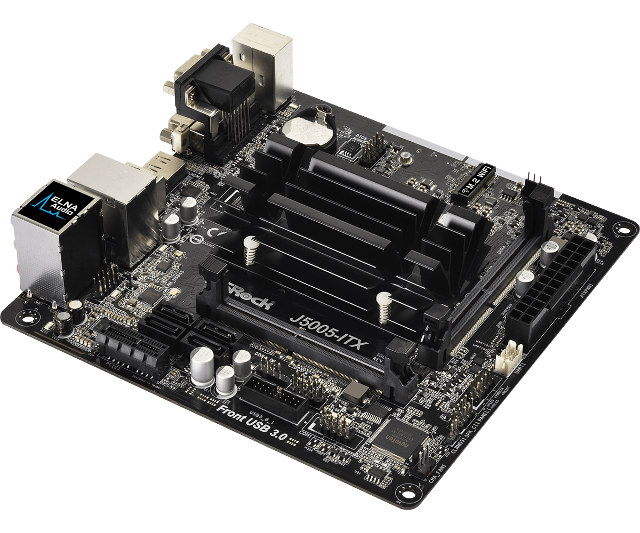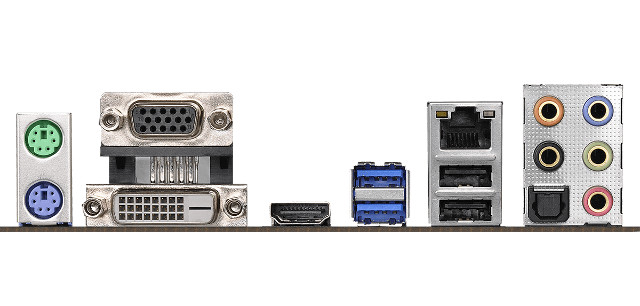Several products based on Gemini Lake processors have already been announced, and some are already available through pre-orders, but so far, I’ve not seen many retail hardware based on Intel Pentium J5005, the most powerful processor of the family, except for one Intel NUC.
ASRock J5005-ITX motherboard brings another option, and while it had been expected for a while, the company has now setup a proper product page, and the motherboard can be seen as “coming soon” for about $120 and up (excluding VAT) on some websites like Alzashop (in Europe) or Kakaku (in Japan).

ASRock J5005-ITX motherboard specifications:
- SoC – Intel Pentium J5005 quad core processor @ 1.50/2.8 GHz with 18EU Intel UHD Graphics 605 up to 800 MHz; 10W TDP
- System Memory – 2x DDR4-2400/2133 SO-DIMM slots up to 8GB (2GB per module not supported)
- Storage
- 2x SATA3 6.0 Gb/s connectors, support NCQ, AHCI and Hot Plug
- 2x SATA3 6.0 Gb/s connectors via ASMedia ASM1061, support NCQ, AHCI and Hot Plug
- 128Mb NOR flash for AMI UEFI BIOS with GUI support
- Video Output
- HDMI 2.0 up to 4K x 2K (4096×2160) @ 60Hz
- DVI-D up to 1920×1200 @ 60Hz
- D-Sub (VGA) up to 2048×1536 @ 60Hz
- Video
- HW Acceleration Decode: HEVC (H.265) 8 bit, HEVC (H.265)10 bit, H.264 @ Lvl5.2 (AVC), JPEG/MJPEG, VP8, VP9 8bit, VP9 10 bit
- HW Acceleration Encode: HEVC (H.265) 8 bit, HEVC (H.265)10 bit, H.264 @ Lvl5.2 (AVC), JPEG/MJPEG, VP8, VP9 8bit
- Audio
- 7.1 CH HD Audio with content protection (Realtek ALC892 Audio Codec)
- Premium Blu-ray Audio support
- 1x optical S/PDIF output port
- HD Audio Jacks: Rear Speaker / Central / Bass / Line in / Front Speaker / Microphone
- Support surge protection
- ELNA audio caps
- Connectivity – Gigabit Ethernet via Realtek RTL8111H with Wake-On-LAN, Lightning/ESD Protection, 802.3az, and PXE support
- USB ports – 2x USB 2.0 ports (with ESD Protection); 2x USB 3.1 Gen1 ports (with ESD protection)
- Expansion Slots
- 1x PCI Express 2.0 x1 slot
- 1x M.2 Socket (Key E), supports type 2230 WiFi/BT module and Intel CNVi (integrated WiFi/BT)
- Internal headers and connectors:
- 1x COM Port Header
- 1x Chassis Intrusion and Speaker Header
- 1x CPU Fan Connector (3-pin)
- 1x Chassis Fan Connector (3-pin)
- 1x 24 pin ATX Power Connector
- 1x Front Panel Audio Connector
- 2x USB 2.0 Headers (Support 3 USB 2.0 ports) (Supports ESD Protection)
- 1x USB 3.1 Gen1 Header (Supports 2 USB 3.1 Gen1 ports) (Supports ESD Protection)
- Misc – 1x PS/2 Mouse Port, 1x PS/2 Keyboard Port, hardware monitor (temperature, fan control, and voltage)
- Dimensions – 17.0 cm x 17.0 cm (mini-ITX form factor)
- Certifications – FCC, CE, ErP/EuP ready (ErP/EuP ready power supply required)
 Except for the more powerful processor, the motherboard has basically the same specifications as ASRock J4105-ITX motherboard, and they share the same user manual. The Windows 10 64-bit drivers and BIOS have also been released on the product page together with the list of tested DDR4 memory modules.
Except for the more powerful processor, the motherboard has basically the same specifications as ASRock J4105-ITX motherboard, and they share the same user manual. The Windows 10 64-bit drivers and BIOS have also been released on the product page together with the list of tested DDR4 memory modules.

Jean-Luc started CNX Software in 2010 as a part-time endeavor, before quitting his job as a software engineering manager, and starting to write daily news, and reviews full time later in 2011.
Support CNX Software! Donate via cryptocurrencies, become a Patron on Patreon, or purchase goods on Amazon or Aliexpress. We also use affiliate links in articles to earn commissions if you make a purchase after clicking on those links.





Ive been waiting for one like this. Thanks
Why the M.2 has always to be for WiFi?
I would rather boot from some tiny SSD and keep the SATAs for Disks…
Because these SoC’s only have six PCIe lanes in total. However, Intel only allows for certain configurations.
Technically this board could support a x2 M.2 slot for SSD’s, but it seems ASRock felt this wasn’t the right option to add…
There’s a PCIe x1 slot so you could try to get a mechanical converter for M.2 key M. But this would result in bottlenecking any fast (and a bit expensive) NVMe SSD and you also need boot/BIOS/UEFI support for NVMe. Most probably I would use the x1 slot for another ASM1061 providing one mSATA slot and another SATA port. E.g. https://www.amazon.de/gp/product/B01GLGINFK/
That ASM1061 adapter looks like something i could use in servers to add an mSATA disk for the OS. Do you know if the drives on that adapters will be bootable?
Well, since those Gemini Lake SoCs support Intel’s CNVi routing 2 PCIe lanes to the M.2 key E hybrid slot (PCIe and CNVi) seems logical. Next 2 PCIe lanes are used for network and the ASM1061 storage controller, then there’s the x1 PCIe slot. So only one lane left and I wonder why they did not use a x2 PCIe slot then?
Sorry, I misread what you wrote. If the M.2 indeed takes two lanes, then yes, there’s no way to do another one for an SSD. Yet another quite limited SoC from Intel…
Can this HDMI port support the range of HDR formats?
Finally!
J5005 is what Gemini Lake is about. Only bad thing is WiFi module not included (not sure can you buy yet module that supports CNVi?)
And also 2133 supported? I always wonder these Asrock support for different RAM, even processor wouldn’t, for sure maybe better buy 2400.
“(2GB per module not supported)”
Urm, no 2GB modules allowed? That seems odd… would 1GB be okay? 4GB? So why not 2?
I think it means per module not per RAM stick. For example you can’t have 8gb in 1 stick with 4 2GB modules.
@tkaiser
Ethernet is only one PCIe lane, as there’s only one Ethernet port.
@Matt
Yes, this is finally Intel’s first decent integrated graphics on a lower-end SoC that can do proper video decoding (driver reliant) and 4k60p.
I would plan the PCIe slot for some TBS quad tuner card.
Always wanted to have such a board but with 1x M.2 or mSATA and 2x SATA + BIOS-disableable 2x over ASM
That way i could start with boot SSD + data HDD + bluray ODD first and disable ASMedia to go below 10W idle
And still could reenable it and add more discs if i need
Sure, but I was talking about ‘2 lanes for Ethernet and ASM1061’. BTW: two Ethernet ports with a single lane would be possible too but chipsets like Intel’s 82571EB are a bit more expensive than the usual RTL8211 used here.
Ok, it’s about power savings then. No idea whether there exist mechanical M.2 key E to M converters (so you can use a NVMe SSD without the need for an additional SATA controller). But I’m surprised that disabling/enabling an onboard ASM1061 seems to be that important. At least when testing with various such controllers on embedded systems I found that adding such a controller on a mPCIe card for example adds 900mW and the same amount for every added SATA drive (PCIe and SATA PHYs both need power). And usually some slight consumption savings are possible by adjusting PCIe link state power management.
Most probably booting from USB or SD/TF card as it’s common in servers is not an option?
@cnx-soft: whats’s the new WP theme named?
That’s Tweentyseventeen theme with some modifications (child theme).
Hyperlinks are now almost invisible 🙁 And quoting does not seem to work any more?
Is the modifications OSS (GP/AGPL/BSD etc) licenced? 🙂 Would really be nice to have.
@TLS
Intel mentioned that their NUC with the Intel Pentium J5005 does not support HDR
https://communities.intel.com/thread/122359#524534
I have emailed Asrock asking a question for HDR info but I doubt I will get a reply.
We will have to wait for CNX to do a proper review to be sure it works will all the audio formats and HDR.
https://communities.intel.com/thread/121993
“Thank you very much for your patience.
Allow me to share with you that the Gemini Lake does not suppoort HDR.”
So a no buy from me. Pretty stupid of Intel to not support HDR in the current year!
Well, then Intel has changed their specs, as originally it was supposed to be supported – https://www.intel.com/content/dam/www/public/us/en/documents/product-briefs/nuc7cjyh-nuc7pjyh-nuc7cjys-brief.pdf
That clearly states HDR support. Keep in mind that there’s half a dozen different types of HDR as well…
More conflicting information direct from Asrock.
“After checking with our R&D, J5005-ITX support HDR.
It could support 4K@60Hz video.
However, Ultra bluray may not supported because it needs Intel driver and player to support.
In the current status, we recommend you to choose Z370 Gaming-ITX/ac or Z270 Gaming-ITX/ac for supporting ultra bluray.”
They keep saying 8GB max on all these Atoms, but the J1900 and N3700 I own from ASRock and Gigabyte have no issue at all with 16GB via 2x 8GB DDR3 SODIMMS. Not that many would spring for large amounts of RAM in this market, but if you should have low power high capacity DIMMs lying around, there is no need to get the lower capacity.
I haven’t tried 32GB: Didn’t have those lying around…
I’m looking at this board and I see that ark states that this processor (j5005 ) supports only 8GB.
But this test https://www.speicher.de/arbeitsspeicher-blog/32gb-arbeitsspeicher-asrock-j4105-itx states that those Gemini Lake processors support up to 32GB.
This is odd.
Why would Intel state such wrong info?
Also https://www.mini-itx.com/~J5005-ITX states the same thing – the board supports up to 32GB
16 GB RAM has been tested in Intel J5005 NUC @ https://www.cnx-software.com/2018/05/16/intel-nuc-kit-nuc7pjyh-review/
I did not know 32GB would work too. We assumed 8GB limitation was per channel, but if 32GB is also supported there must be another explanation.